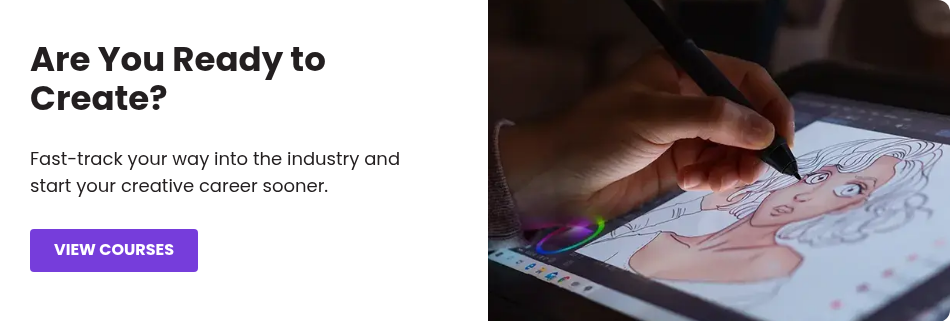We spoke with 3D visualization student Gizem about her journey from games to VFX to 3D visualization and how, with the help and support of her mentor, she found her niche and landed a relevant role in the industry before she even finished her studies.
In our exclusive interview, Gizem also offers insights into the daily life of a 3D visualization artist, the hiring process, and how her diverse background has shaped her unique approach to the industry.
Hi Gizem, please tell us about your new job!
Hello! My days here are quite varied, which I really enjoy. We usually start with discussions about ongoing projects and client feedback, which I think is essential for setting priorities and planning my tasks for the day. I spend a lot of time creating detailed 3D models and visualizations of home interiors and exteriors.
Since I’m new to this role, I feel like every day is a learning experience for me. I’ve been given significant projects right from the start, and I’m genuinely grateful to my supervisor, Artem, for trusting me with such important responsibilities. In my opinion, jumping right into major projects is the best way to learn—kind of like diving into the deep end when learning to swim.
One of the things I love about working at this architectural visualization company is the diversity of projects. I get to work on everything from cozy room designs to large-scale residential developments. This variety keeps things exciting and offers me plenty of opportunities to continuously improve my skills.
We have a cozy office space, though some of my teammates work from home. Everyone here is really supportive and passionate about what they do.
Overall, the transition from VFX to architectural visualization has been smoother than I expected. My background in modeling definitely helps, and the supportive environment here makes a big difference.
How did your mentorship at CG Spectrum influence your career path?
My mentorship at CG Spectrum had a profound impact on my career path. Before I joined the 3D modeling program, I was a self-taught 3D artist who felt pretty overwhelmed by the sheer number of learning resources available and unsure about which direction to take.
I think what really made a difference for me was the structured environment and the direct access to experienced mentors at CG Spectrum. It provided the clarity and guidance I needed at that time.
After graduating, I worked on a personal environment project called Sunflower Field. As I was nearing the finish line, I shared it with our 3D modeling community on Slack to get some feedback from mentors and fellow students.

Architectural visualization by Gizem using 3ds Max and Corona.
Our student manager suggested I reach out to Nicklas Byriel, the head of the 3D visualization department and a professional 3D visualization artist. Nicklas provided me with incredibly detailed feedback that made me realize just how crucial visualization skills are for achieving realistic results.
In my opinion, Nicklas' feedback was a real turning point for me. It led me to pursue further education in architectural visualization at CG Spectrum. This newfound focus naturally extended into my professional life.
I’ve enjoyed working on environment projects, especially creating interiors. I think my experience and passion for this field really came together through that mentorship.
What was the hiring/interview process like?
The hiring process was surprisingly efficient and straightforward. I first met Artem, who is now my boss, at a 3D Meetup in Berlin. It was a casual event where everyone brought their own drinks and sat together, getting to know each other and chatting about the industry.
My conversation with Artem felt more like a friendly chat than a formal interview. We discussed the company's workflow, the software they use, and I shared my background and my decision to switch from VFX to become an archviz artist.
A few weeks later, I sent an application to Artem on LinkedIn since they didn't have any open positions listed on their website. To my surprise, we set up a meeting within half an hour for the following Monday.
During that week, I went to the office for onboarding sessions on Thursday and Friday. By the following Monday, I had signed my contract and officially started the job.

How did you incorporate your prior 3D modeling and VFX experience when highlighting your background in the interview process?
When I followed up with my application, I made sure to highlight my experience with 3D modeling, which I think is a crucial skill shared across VFX, game, and architectural visualization.
I talked about my work related to architecture, including modeling environments, interiors, and exteriors, as well as my experience with creating vegetation and set design.
In my opinion, this approach really helped to show that I have a solid foundation and that my skills are highly transferable to architectural visualization.
I also made a point of sharing my long-standing passion for buildings and architecture, which naturally led me to this field. Combining this personal interest with my professional background helped me convey why I was so enthusiastic about the role and how my experience made me a strong fit for the transition.
Have you also found your former film and games experience useful in your day-to-day tasks?
I think the skills I developed working in the VFX and game industry have been incredibly valuable. Lighting, texturing, and modeling complex scenes have directly translated into the work I do now in architectural visualization.
One of the most exciting things has been how my previous roles taught me to stay adaptable and embrace new tools and technologies. This mindset has been invaluable in the fast-paced world of architectural visualization.
 Close-up of Gizem's 3D rendered interior.
Close-up of Gizem's 3D rendered interior.
Whether it’s tweaking a lighting setup or perfecting a texture, my past experiences have added both creative flair and technical precision to my current work.
So, if you’re coming from a different background, don’t underestimate how your previous experiences can enrich your new role. I believe you’ll find that they can offer fresh perspectives and innovative approaches that will make your work stand out.
How did CG Spectrum prepare you for the role?
I feel really fortunate to have had the chance to connect with such a diverse group of mentors and industry professionals at CG Spectrum. The advice and feedback I received were not just helpful—they were transformative.
The hands-on experience I gained from CG Spectrum’s programs was invaluable. The supportive community there gave me the confidence to start and complete my own personal projects and embrace new challenges from the very beginning. I truly believe that this preparation was key, not only for landing a job but also for making a smooth transition into my new role.
One of the highlights for me was working with Nicklas, the head of our visualization department. We had in-depth conversations about my projects, discussed potential companies where I could apply.
Nicklas helped me understand the architectural visualization field better, which was completely new to me, and provided practical advice on how I could further develop my skills. I believe his personalized guidance was incredibly helpful in navigating my career path.

What was the most challenging aspect of your studies at CG Spectrum, and how did it prepare you for a career in the industry?
One of the most challenging aspects of my studies at CG Spectrum was the steep learning curve involved in mastering the new tools and techniques required for getting a job in architectural visualization. Coming from a VFX background, I had to adapt quickly to a different set of industry standards and workflows, which at first felt pretty overwhelming.
But I think that challenge was also what made the experience so valuable. I was constantly pushed out of my comfort zone, whether it was tackling complex projects or adapting to industry-specific standards.
What really helped was the hands-on approach and the constant feedback from mentors like Nicklas. They didn’t just teach me the technical skills—I learned how to think creatively and critically to solve problems in real-world scenarios.
Tackling these challenges head-on really prepared me for the realities of working in the industry. It taught me the importance of being resilient and adaptable and to embrace continuous learning. These skills are absolutely essential in such a fast-paced and ever-evolving field.
Looking back, I’m grateful for those tough moments because they gave me the confidence to take on bigger projects and navigate my career with a strong foundation.

3D visualization of a bathroom interior by Gizem.
What’s your advice for people looking to get into the industry?
If you're looking to step into architectural visualization, my advice is to embrace change with open arms. This field is always evolving with new tools and techniques, and it can be overwhelming at first. But trust me, change is your ally, not your enemy. They’re a part of the adventure and can lead you to exciting new possibilities.
Don’t be afraid of the shifts and updates; embrace them because they are an opportunity to grow and refine your skills. Instead of clinging to what’s familiar, be curious and open to learning. Let go of old habits or practices that don’t serve you anymore.
One thing I’ve learned is that it’s never too late to start or switch gears. Whether you’re a recent graduate, changing careers, or just feeling stuck, there’s always room to grow and adapt.
What are your hopes for the future regarding your career?
Looking ahead, my hopes for the future of my career are rooted in growth, creativity, and making a meaningful impact. I aim to work on projects that not only challenge me creatively but also resonate with clients and audiences on a deeper level. I want to create visualizations that don’t just depict spaces but also tell a story, evoke emotion, and inspire.
In addition to personal growth, I hope to reach a point in my career where I can give back by mentoring others, much like the valuable personalized support I received from mentors like Nicklas at CG Spectrum.
I’ve seen firsthand how this support can help shape your career, and I’d love to help others navigate their own paths in this industry.
You can continue to follow Gizem's journey on Instagram, Behance, and LinkedIn. You can also listen to our podcast episode with Gizem where she talks more about transitioning from games and VFX to 3D visualization. We can't wait to see what you create next, Gizem!
Want the same level of guidance and support from industry pros while you make your way into the industry as Gizem did?
Gizem’s journey highlights just how impactful the right mentorship can be in carving out a successful career in 3D visualization. At CG Spectrum, our courses are designed to offer you a level of guidance and support you won't find at other training centers.
You'll gain direct access to industry professionals who have worked on top films and games. These experts will be with you every step of the way, sharing unique industry insights and providing invaluable feedback on your work to help you refine your skills and achieve your career goals.
Dive into the dynamic world of 3D visualization and experience the difference that expert mentorship can make!

Related Links




